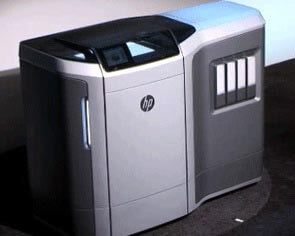IDC: U.S. 3D-Printer Shipments Up Nearly 20 Percent in 2015

HP Inc.’s MultiJet Fusion 3D printer.
A newly published forecast from market-research firm International Data Corporation (IDC) shows that 3D-printer shipments in the United States grew by almost 20 percent in 2015 compared to 2014. Additionally, total 3D-printer shipments in the United States are expected to experience a compound annual growth rate (CAGR) of more than 16 percent through 2020.
“People and companies that are adopting 3D printers are routinely realizing tremendous time and cost savings in their product creation and development cycles. As printer speeds increase and the range of materials expands, a growing number of products and parts, and therefore markets, will be impacted by 3D printing/additive manufacturing,” commented Tim Greene, research director for IDC’s Hardcopy Solutions. “Already the 3D-printer mix in the U.S. has changed over the last 12-24 months. While there are still a lot of shipments into the DIY (do-it-yourself)/consumer market, tremendous growth remains in the segments with a more professional and manufacturing orientation. Leading 3D-printer manufacturers are adopting new processes throughout their operations to reposition their businesses for this change.”
Segment highlights from IDC’s forecast include:
- Shipments in the very low-end, where 3D printers sell for below $1,000, are still projected to grow at a CAGR of more than 12 percent through 2020. These printers, nearly all of which are FFF/FDM-based, are becoming more useful with the expansion of materials that can be reliably 3D printed.
- IDC expects strong growth (20 percent and higher) in professional 3D-printer segments, which rely on a range of technologies that provide more accurate and durable 3D objects, often at much higher rates of speed.
- Shipments at the very high-end of the market, which are primarily based on materials jetting and sintering/melting technologies, are expected to grow at an aggressive rate over the next few years as a growing number of companies use these systems for high volumes of professional prototypes and on-demand parts manufacturing.
Technology highlights from IDC’s forecast include:
- FFF/FDM printers accounted for over 75 percentof total shipments in 2015, but by 2020 IDC expects this segment will make up less than 60 percent of total shipments.
- 3D printers based on stereolithography (SLA) are expected to go from about 11 percent of total shipments in the United States in 2015 to over 20 percent by 2020.
- Sintering/melting 3D-printing technologies are seeing dynamic growth over the forecast period as existing users increase their investments in these technologies at the high-end, while new market entries are lowering the cost to invest in these technologies, democratizing the ability to produce high quality and highly durable 3D builds.
- Mcor’s Select Deposition Lamination (SDL) 3D-printer technology has been repositioned at a lower price point, which, according to IDC, should drive higher shipment levels across a wide range of vertical segments.
- Materials-jetting is another of the most dynamic technology segments. Over the forecast period, IDC expects this segment to be spurred by worldwide 3D-printing market leaders 3D Systems and Stratasys, now joined by HP.
“The growth of the 3D-printer hardware market is just part of the total 3D printing/additive manufacturing picture,” added IDC’s Greene. “Printer-hardware revenue combined with the expansion of 3D-printing services and the consumption of materials already represent a $2.5 billion market in the U.S. in 2015, and that is expected to grow at a rate of more than 20% through 2020.”
The IDC report, U.S. 3D Printer Forecast, 2016-2020: New 3D Print/Additive Manufacturing Technologies Fuel Growth (Doc #US41333516), forecasts overall shipments and revenues for the 3D printer market in the United States. T,he report provides a detailed analysis of 3D-printer shipments and revenues by technology and price band. Significant market developments and key market drivers and inhibitors are also presented.
More Resources
- May 2016: Aiming to Disrupt Production-Inkjet Printing, Xerox to Preview Object Inkjet Printer for Printing on 3D Objects
- May 2016: Ricoh’s First 3D Printer Now Available in Europe
- May 2016: XYZprinting to Preview 3D Printer that Uses Memjet Print-Head Technology
- May 2016: It’s Here: HP Delivers Two Jet Fusion 3D Printers Designed to Reinvent Prototyping and Manufacturing
- April 2016: Consumer 3D-Printer Maker MakerBot has Sold over 100,000 3D Printers Worldwide
- April 2016: 3D-Printing Market to Hit $30.19 Billion by 2022 According to MarketsandMarkets Report
- April 2016: 3D-Printer Industry Soars to $5.2 Billion in 2015, According to Latest Wohlers Report
- April 2016: Stratasys’ New Multi-Material J750 3D Printer Sets the Bar for Most Realistic 3D-Printed Objects
- March 2016: Kodak and Carbon 3D to Jointly Develop 3D-Printing Technology
- March 2016: Top 3D-Printer Brands Moving Away from Consumer 3D Printing
- February 2016: Sindoh Enters 3D-Printer Market with 3DWox, Which Features Internal Monitoring Camera
- January 2016: IDC: Global Spending on 3D Printing Will Grow at 27 Percent CAGR

You must be logged in to post a comment.